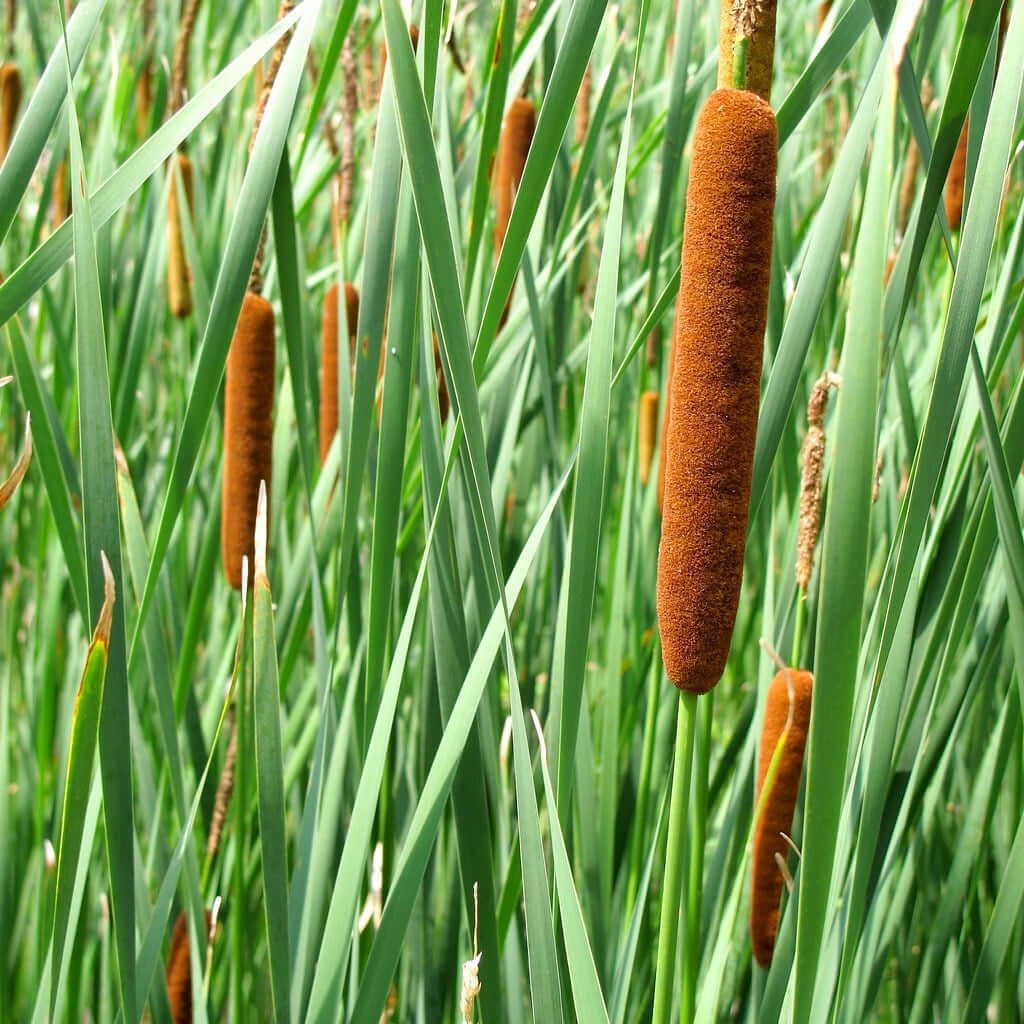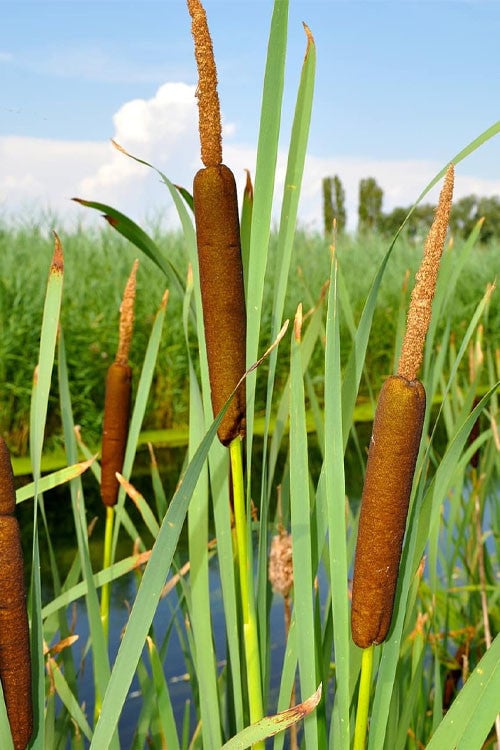



Cattail Plant
Improves water quality naturally
Provides erosion control benefits
Creates lush, green visual appeal
Thrives in
ZONE 3ZONE 4ZONE 5ZONE 6ZONE 7ZONE 8ZONE 9ZONE 10ZONE 11This plant ships:
May 251 Year Guarantee on all plants
Cattail Plant - Typha
The Cattail Plant (Typha) is perhaps the most iconic wetland grass that everyone knows and loves. One quickly recognizes it by its hotdog-shaped blooms that are nestled in between slender and breezy blades. Miraculously able to stand tall in several feet of water, this grass is truly one-of-a-kind. It is a popular go-to for gardeners looking to populate the wettest areas of a landscape, bringing several benefits other than its unique appearance. This grass provides not only endless visual interest for your pond or lake but also acts as a crucial player in enhancing environmental stability.
Plant Details - Cattail Plant
Family: Typhaceae
Light Requirement: Full Sun – Partial Shade
Water Needs: Very High
Height: 4-10 ft.
Spread: Indefinitely with clumping rhizomes
Growth Rate: Fast
Bloom Time: Late Spring - Summer
Flower Color: Brown
Wildlife Value: Provides food and shelter for wildlife, provides nesting material for birds
The blades of this grass are quite long and have a slightly waxy outer layer that provides extra reinforcement. This powerful spreader thrives in the wettest conditions possible, preferring to live in shallow water or consistently moist mud. This means they are most often found naturally in marshes, along muddy banks, or nestled in pond water. It spreads incredibly fast in clumping colonies with an indefinite horizontal spread. The memorable flowers are a solid brown upon maturity and go to seed by early fall.
Landscape Uses and Maintenance - Cattail Plant
This powerful grass is a dynamic add to a wet habitat. Its dense root structure holds onto wet, loose soil and acts efficiently to control erosion. The clump-forming, densely leafed habit of the plant provides a preferred shelter for many aquatic and semi-aquatic animals, who also appreciate its materials for nesting purposes. Once planted, the Cattail Plant requires almost no maintenance, but it may be prudent to cut the plant back regularly to prevent excessive spreading, otherwise it may quickly take over an entire area.
Noteworthy Characteristics
The Cattail Plant is easily identified by its unique, cylindrical flowers, whose thickness and color resembles the tail of a cat, which is the trait that inspired its name. When summer passes, the flowers form into dense seed heads that dry out and burst open, releasing fluffy seeds. If you take a clump of the seeds, you will notice the distinct, soft cotton-like texture.
This Is How Your Plants Will Look upon Delivery

Bloom Season
Summer
Bloom/Foliage Color
Brown
Height at Maturity
Under 10 Feet
Care
Cattail plants thrive in wet conditions, which makes them ideal for ponds or marshy areas. Ensure their soil is consistently moist and provides plenty of space for spreading roots. Prune back old stems in late winter to encourage new growth.
Plant Reproduction
Cattail spreads via rhizomes and seeds in waterlogged conditions.
Shipping date depends on the date displayed and chosen when you order from the product's page.
We only accept returns on plants verified dead. If you think your plants have died, we offer a 1 year warranty, please use this File a Claim Link to verify dead plants and start with return warranty process.






Striking Visual Appeal:
Cattail Plant adds a distinctive vertical element to any garden with its tall, reed-like stems and unique brown flower spikes. It’s perfect for creating visual interest and texture, bringing a dynamic and attractive look to wetland landscapes.
Ideal for Wet Conditions:
Thrives in wetland areas, ponds, and water gardens, making it an excellent choice for damp or marshy landscapes. Enjoy a thriving plant where others might struggle, ensuring lush greenery in water-rich environments.
Air and Water Purification:
Plays a role in filtering and purifying water and air, contributing to a healthier environment. It’s a natural way to enhance the ecological quality of your garden, promoting cleaner surroundings.
Natural Erosion Control:
Helps stabilize soil with its dense root system, preventing erosion in wet areas. It’s a practical and attractive solution for maintaining healthy, stable landscapes, protecting the integrity of your garden's design.
Caring Tips
How do I care for my Cattail Plant?
Each box contains detailed care instructions and information about your product. But here's the basics.
Care Tips
Cattail plants thrive in wet conditions, which makes them ideal for ponds or marshy areas. Ensure their soil is consistently moist and provides plenty of space for spreading roots. Prune back old stems in late winter to encourage new growth.
Light Requirements
Cattail plants thrive in full sun to partial shade. They prefer bright, direct sunlight but can tolerate some shade, especially if they receive sunlight for at least a few hours a day. Ensure they are in a moist, wet environment.
Hardy Planting Zones
3 • 4 • 5 • 6 • 7 • 8 • 9 • 10 • 11
Header
Use this content to share information about your store and products.
Frequently Asked Questions
How often should I water my plants?
How do I know if my plant is getting too much or too little sunlight?
What should I do to prepare my plants for winter?
What are the signs that my plant needs fertilizing?
How can I prevent pests from damaging my plants?
How do I choose the right plant for my climate zone?






